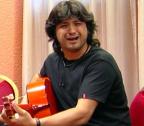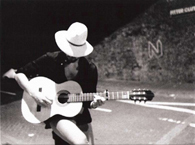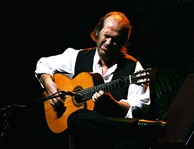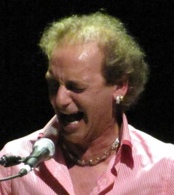Welcome to one of the most active flamenco sites on the Internet. Guests can read most posts but if you want to participate click here to register.
This site is dedicated to the memory of Paco de Lucía, Ron Mitchell, Guy Williams, Linda Elvira, Philip John Lee, Craig Eros, Ben Woods, David Serva and Tom Blackshear who went ahead of us.
We receive 12,200 visitors a month from 200 countries and 1.7 million page impressions a year. To advertise on this site please contact us.
|

|
|
Bulerias Compas - keeping track
|
You are logged in as Guest
|
|
Users viewing this topic: none
|
|
Login  | |
|

   
JasonM
Posts: 2055
Joined: Dec. 8 2005
From: Baltimore

|
 Bulerias Compas - keeping track Bulerias Compas - keeping track
|
|
|
I'm ashamed to admit that after all these years of playing or listening to flamenco, I suck at compas. Always have. I don't practice rhythm enough either because it just stresses me out really quick. Always liked to tap my foot every other beat when playing but ii can loose track of which half of the cycle I'm in taping like a metronome. I'm talking Bulerias here because nothing else matters ;)
Anyway, don't get me wrong, I'm no noob. I'm talking about when rhythm gets complex, and I want to keep track of where things are in the compas, yet feel what's going on rhythmically. I get in trouble with Amigo, or Paco falsetas for example. Really getting a good grip on things. I can listen and feel the compas, but I can't always do that and get locked in on syncopation in falsetas at the same time.
You could say well, go back to basics, play for dance class, practice metronome, etc. We'll I have. It's almost like a threshold I'm trying to cross. It's hard to convey typing on an ipad, and frankly a pain in the arse,it's 2:30 am and I don't know what I'm asking really...
Ok, take this video...
http://youtu.be/yfChcoSoa1E
Basic palmas. Talks about rise and fall with a 6 count. Accents on 2 and 4. Beats 5 and 6 are kind of a break and add swing. Ok, simple. I hear it all the time. Especially when tempo is too fast to count. But where does the 4 fall in the 12 cycle? Is it 12, 3, 10. Feels like it's 3 but it doesn't work out either to me. Or is it just a way to feel compas and not transpose to 12,3, and 10 accents?
|
|
|
|
REPORT THIS POST AS INAPPROPRIATE |
Date Aug. 18 2014 6:46:57
 |
|

   
mark indigo
Posts: 3625
Joined: Dec. 5 2007

|
 RE: Bulerias Compas - keeping track (in reply to dartemo1) RE: Bulerias Compas - keeping track (in reply to dartemo1)
|
|
|
quote:
When playing in threes it looks like José is accenting 1 2 3 4 5 6 7 8 9 10 11 12 etc.
when he counts "un dos tres un dos tres" at 3:20 and again when he counts and starts to play tapeado (muted strings) at 3:40 he is giving the compas a simpler count. His "1, 2, 3, 1, 2, 3" is actually "12, 2, 4, 6, 8, 10"
Then when he starts to play on a chord just after (3:45-ish) he is accenting 12, 3, 6, 9. Then he puts in some closures of the compas. These accent 10 (like in the "classic" 12, 3, 6, 8, 10 accents). But note, the rasgueado ends on 10, but starts on 9, so that sort of links up the two sets of accents (in my head anyway, and I don't really think of it in numbers or count while I play, and find it is actually much simpler without all the counting analysis which just seems to make it sound really complex).
At around 5:50 He counts again the "normal" 12,1,2,3,4,5,6,7,8,9,10,11, and then goes into rhythmic vocalisation of the rhythm. Go with that, it's actually much more useful than counting.
The last lessons I had in Spain the teacher taught all the Bulerias we did without counting anything, just with the foot on "1, 2, 3, 1, 2, 3" (which as explained above corresponds to "12, 2, 4, 6, 8, 10"). It was much easier than having someone count all the time, which I find really offputting, 'cos then you can't actually hear the falseta you're supposed to be learning! 
With this video, following Ricardo's advice: quote:
lose the counting concept and use a metronome and Todd's advice:quote:
Get the numbers out of your head. That is what's messing you up. Stop trying to count. is easy, or at least possible. 
_____________________________
|
|
|
|
REPORT THIS POST AS INAPPROPRIATE |
Date Jul. 27 2017 13:58:33
 |
|

   
Erik van Goch
Posts: 1787
Joined: Jul. 17 2012
From: Netherlands

|
 RE: Bulerias Compas - keeping track (in reply to JasonM) RE: Bulerias Compas - keeping track (in reply to JasonM)
|
|
|
Didn't see above reaction of Mark, so i unintendedly second him
quote:
ORIGINAL: dartemo1
I have a question regarding switching from “12” bulerias compass 12 1 2 3 4 5 6 7 8 9 10 (11) to “threes” or “twos”. When playing in threes it looks like José is accenting 1 2 3 4 5 6 7 8 9 10 11 12 etc. .....
One the other hand, I found that dancers often hear the compass as 12 1 2 3 4 5 6 7 8 9 10 11.
Like Mark mentioned above Josés 123/123 does indeed equal the pulse 12-2-4/6-8-10-. So it basically counts the even beats of bulerias and rather then calling them 12-2-4-/6-8-10 he gives them the neutral names 1-2-3- just to emphasize he feels a chain/pulse of 3 "beats". His 123/123 equals my *-*-*-/*-*-*- he simply calls my neutral dots 1,2 and 3.
The other pulse you mention 12 1 2 3 4 5 6 7 8 9 10 11. is quite the opposite of that 123 (12-2-4-) pulse and is the other side of the coin of counting in "threes' or and "twos". That pulse equals my *--*--/*--*--. Like stated earlier the first dot is either 12 or 6 so as far as i'm concerned your alternative 1 2 3 4 5 6 7 8 9 10 11 12 etc. probably has to be considered a mis understanding.
As far as switching from "12" bulerias compas into "trees" and "two's" is concerned, i explained that previously. In short the basic compas exist out two halves
12--3--/6-8-10-
so the first half of the compas has the pulse *--*-- and the other half has the pulse *-*-*- (Jose's 123) and as such represent the 2 sides of the coin (6 beats felt as 2 groups of 3 and 6 beats felt as 3 groups of 2).
In reality both halves can be combined randomly to your likings so a melody can follow the "three" pulse over a longer period of time, it can follow the "two" pulse over a longer period of time and you can vary them to your likings. Quite often melody lines are constructed in such a way that 2 of these chains pair to become a full compas again. But it is perfectly possible to put in a so called half compas, a chain of 6 beats without a matching second half. The trick is to feel comfortable in changing from *--*-- into *-*-*- without thinking and just feel the pulse as a pulse without lossing yourself in counting. The most important part is knowing how to round things up which is explained in my previous post.
quote:
Similarly, playing in twos can be done as 12 1 2 3 4 5 etc. or 12 1 2 3 4 5 etc. I am a bit confused. Thank you.
i'm not so sure about the second option (1-3-5-) i think you miss understood that from above video.
I annotated the 12-2-4-(6-8-10-) pulse as "*-*-*-", he calls it 1-2-3-. I like to add that when i listen to bulerias or analyze it for myself or a student i tend to give every * it's own place on a horizontal line. So rather then calling it 1-2-3- (which can be a bit confusing considering the fact one could accidentally link that 1 to 1 in bulerias were actually it represents either beat 12 or 6) i tend to feel that "123 pulse" as left, middel, right, were my counting finger or mind (imaginary) jumps on a horizontal line from left>middle>right/left>middle /right. The *--*-- pulse i count in a similar way switching between left and right. By doing so i always know were i am and especially when the material i listen to is extremely complex that left/middle/right strategy (similar to his 123) is extremely helpful in being sure i'm still "in compas". Sometimes i have no clue what they are doing, all i know for sure is if they end correctly....or not :-).
_____________________________
The smaller the object of your focus the bigger the result.
|
|
|
|
REPORT THIS POST AS INAPPROPRIATE |
Date Jul. 27 2017 15:36:35
 |
|

   
Ricardo
Posts: 14806
Joined: Dec. 14 2004
From: Washington DC

|
 RE: Bulerias Compas - keeping track (in reply to dartemo1) RE: Bulerias Compas - keeping track (in reply to dartemo1)
|
|
|
quote:
ORIGINAL: dartemo1
Hi, I want to revive this interesting thread. I have a question regarding switching from “12” bulerias compass 12 1 2 3 4 5 6 7 8 9 10 (11) to “threes” or “twos”. When playing in threes it looks like José is accenting 1 2 3 4 5 6 7 8 9 10 11 12 etc. Also Ricardo explained that the pattern goes as 1 2 3(golpe) 4 5 6(golpe) 7 8 9(golpe) etc. It sounds right and automatically takes care of things like 1,2,3 llamadas and desplantes. One the other hand, I found that dancers often hear the compass as 12 1 2 3 4 5 6 7 8 9 10 11. Also closing is a bit easier with keeping A chord on 12-1-2 and switching to B flat on 3-pause. Similarly, playing in twos can be done as 12 1 2 3 4 5 etc. or 12 1 2 3 4 5 etc. I am a bit confused. Thank you.
First of all, don't think of it as "switching rhythm" as if the feeling has changed. Fundamentally you need to keep the same feeling throughout...as this "switching gears" might affect your tempo and groove unintentionally. The thing about the feel of 2s and 3s is that the magic number is 6, there is a symmetry that ties it all together fundamentally.
Here is the simple way to keep it all going. 12,2,4/6,8,10 are the basic beat that you can tap your foot on or feel inside. That means the odd counts are the up beat, but you have to feel something special about the 3 and the 9. It's an up beat accent feeling but you also change chords on those beats. Putting a rasgueado on those accents makes it more clear that there is symmetry. I call the 3 and the 9 the "tail" of the phrase and therefore 12 and 6 are the "head" of the phrases, or downbeat feelings. Once you get the feeling for head or tail, you no longer need to count or think of numbers.
_____________________________
CD's and transcriptions available here:
www.ricardomarlow.com
|
|
|
|
REPORT THIS POST AS INAPPROPRIATE |
Date Jul. 27 2017 17:28:52
 |
|
 New Messages New Messages |
 No New Messages No New Messages |
 Hot Topic w/ New Messages Hot Topic w/ New Messages |
 Hot Topic w/o New Messages Hot Topic w/o New Messages |
 Locked w/ New Messages Locked w/ New Messages |
 Locked w/o New Messages Locked w/o New Messages |
|
 Post New Thread
Post New Thread
 Reply to Message
Reply to Message
 Post New Poll
Post New Poll
 Submit Vote
Submit Vote
 Delete My Own Post
Delete My Own Post
 Delete My Own Thread
Delete My Own Thread
 Rate Posts
Rate Posts
|
|
|
Forum Software powered by ASP Playground Advanced Edition 2.0.5
Copyright © 2000 - 2003 ASPPlayground.NET |
0.0625 secs.
|


 Printable Version
Printable Version












 New Messages
New Messages No New Messages
No New Messages Hot Topic w/ New Messages
Hot Topic w/ New Messages Hot Topic w/o New Messages
Hot Topic w/o New Messages Locked w/ New Messages
Locked w/ New Messages Locked w/o New Messages
Locked w/o New Messages Post New Thread
Post New Thread